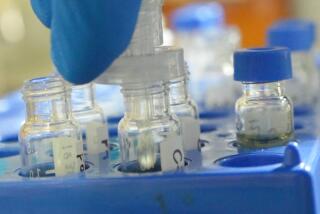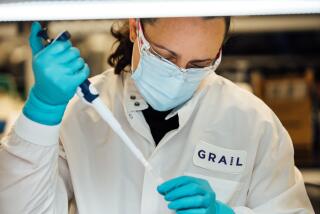Anthrax testing is imperfect science
(RealVideo and QuickTime)
WASHINGTON — Pornographic material mailed to a Microsoft office in Reno, Nev., tested positive for anthrax on an initial screening. A second, more sophisticated test came out negative, but a third test -- all at the same Nevada State Lab -- showed positive results.
The Centers for Disease Control and Prevention is now looking at the material, and a spokesman says preliminary indications are that the sample is negative.
The flip-flopping results highlight how unreliable tests for the deadly bacterium can be -- both for suspect substances and the people who may have been exposed to them.
Experts say field tests are particularly error-prone and can produce false positive or false negative results. More extensive laboratory procedures have their own limitations. And accurate tests for bacterium in people are even more problematic.
The inconclusive results have heightened the agony for the people involved and the nation watching their plight so carefully.
But public health officials involved in the anthrax scare and experts around the country say certainty is not possible given the fallibility of the tests.
“It’s confusing to the public but its not confusing to us, because we know there can be equivocal testing that needs to be verified,” said Bob Salcido, a Nevada investigator who worked on the case.
Even when the stakes are high, conclusive findings take time. Senate Majority Leader Tom Daschle’s office discovered a suspicious letter about 10:30 a.m. Monday, but Capitol Police did not get final confirmation that the substance was anthrax until late that evening.
“This certainly warranted rapid response; Tom Daschle’s office would get the fastest analysis available,” said Calvin Chue, a research scientist for Johns Hopkins University’s Center for Civilian Biodefense Studies.
Investigators on the scene of an anthrax scare can do preliminary field tests with a simple device that resembles a home pregnancy tests or high-tech, suitcase-sized DNA scanners -- the gold standard for field tests. Both have limitations.
“None of the rapid tests can be considered a final confirmation,” Chue said. “The tradeoff for being very rapid is it’s not 100 percent accurate. There is no single test that is 100 percent.”
A false positive can result if the tests is fooled by another member of the bacillius family, which includes anthrax and a large number of less benign bugs.
“These tests are very fast but they do have a tendency for false positives,” said Gary Andersen, a senior scientists at Lawrence Livermore National Laboratory.
False negatives are possible if there was simply not enough bacteria in the particular sample that was tested.
“This is why a sample may test negative a couple times, but a more sensitive third test would pick it up and you can say the test is positive,” Chue said.
Back in the lab, scientists spread a specimen in a petri dish and place it in an incubator for 18 to 24 hours at body temperature to see if the anthrax bacterium grows. Once the bacterial colonies appear, several different tests are used to try to confirm the presence of anthrax.
In the Nevada case, two of these tests came out positive and another -- a direct fluorescent antibody test -- was negative, according to Salcido, who works at the state emergency operations center.
The final verdict lies with the Centers for Disease Control and Prevention, which has the ability to perform sophisticated DNA tests as well as more advanced bacterial culture analysis.
“The one we have is looking like its going to be negative,” said Lisa Swenarski of the CDC.
“The bottom line is that’s not going to determine whether someone needs treatment or not,” Swenarski said. “Even if you test negative you need to stay on the antibiotics.”
The incubation period may be as long as 50 days for anthrax spores that have been inhaled, that is why people are given 60-day regimes of antibiotics.
More to Read
Sign up for Essential California
The most important California stories and recommendations in your inbox every morning.
You may occasionally receive promotional content from the Los Angeles Times.










